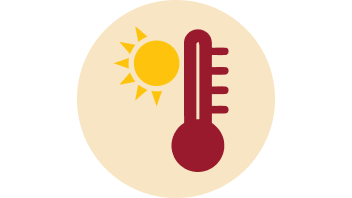Extreme heat
Climate change is expected to increase the frequency, intensity, and duration of heat waves. This may increase the risk of heat-related illnesses, especially for those at risk.
Symptoms of heat-related illness
Adverse health effects that can occur from exposure to excessive heat include:
- heat rash: red or pink rash usually found on the neck, chest and/or elbow creases
- heat cramps: painful muscle cramps
- heat exhaustion: heavy sweating, weakness, dizziness, nausea, vomiting and fainting
- heat stroke: headache, dizziness, confusion, fainting and high body temperature; skin may be hot and dry or damp; this is a medical emergency – seek emergency help and cool the person down right away
Other health problems can also occur, especially for those with chronic medical conditions such as heart disease or diabetes.
Consult a healthcare provider or call
In the event of medical emergency (for example, loss of consciousness), call
Individuals at high risk of heat-related illness
During an extreme heat event, everyone is at risk, but some groups are more vulnerable than others. They include:
- infants and young children
- people who are pregnant
- older adults
- people who live alone
- people with chronic medical conditions (for example, heart disease, respiratory conditions, overweight, diabetes) or mental illnesses (for example, schizophrenia, depression, dementia)
- people on certain types of medications (for example, for high blood pressure, for mental illnesses, etc.)
- people experiencing homelessness, those who are underhoused, or encounter other challenges in accessing cool spaces
- people with limited mobility
- people who exercise vigorously outdoors (play sports, cyclists, gardeners)
- outdoor workers (depending upon length or time and exertion levels)
- people who work in places where heat is emitted through industrial processes (for example, foundries, bakeries, dry cleaners)
footnote 1
Some municipalities provide heat relief programs (for example, cooling stations) during extreme heat event. If an "Extreme Heat Alert" is in effect, check with your municipality or local public health unit to locate what’s available near you.
How to prevent heat illnesses
Be aware and prepared to handle an extreme heat event. If you have any symptoms during extreme heat (for example, feeling dizzy, weak, or overheated), you should:
- immediately move to a cool place (that is, indoor environments <26°C)
- rest by sitting or lying down
- drink water
Remember to take it easy after feeling better from cooling off, as you may still be at risk afterwards.
Stay hydrated
- Dehydration may occur more easily during a heat event. Drink fluids, especially water, before feeling thirsty. Sugary or alcoholic drinks can cause you to lose more body fluid. Also avoid very cold drinks, because they can cause stomach cramps.
Stay cool
- Dress in light-coloured, loose-fitting clothing, wear a hat and apply sunscreen.
- If feasible, open your windows at night and create a cross-breeze. Close awnings, curtains, or blinds during the day to reduce heat indoors.
- If you have an air conditioner, set it to a comfortable temperature. For those at risk during extreme heat events, sustained exposure to indoor environments over 26°C can pose a risk to health.
- Reschedule activities as needed to avoid being out when it’s hottest.
- Avoid using the oven or other appliances that will add heat to your home.
- If you must do physical activity in the heat, take extra breaks, remove excess clothing, and keep hydrated.
If you are outdoors
- Spend the hottest part of the day (typically noon to 2 p.m.) in air-conditioned public buildings (for example, mall, library, cooling station).
- Reschedule or plan outdoor activities during cooler parts of the day.
- If you must do physical activity in extreme heat, take extra breaks to let your body cool off and drink lots of water.
- Give your body time to recover after being in the heat. Wear a hat to protect your face, UV-protective eyewear for your eyes, and apply sunscreen (SPF 30 or greater) to prevent skin cancer.
Health checks for those at risk
If feasible, check up on friends, family, or neighbours who are at increased risk during extreme heat events, particularly if they do not have access to functioning air conditioning, as elevated indoor temperatures may be higher than they seem. This may involve asking them what the specific temperature is on their thermostat, or an in-person visit.
While fans may provide some heat relief, they may be insufficient to fully cool someone down. A proper air conditioning unit is preferred.
Do not leave people or pets in parked vehicles as they can get very hot!
Prepare now
- Consider having a water supply ready, as well as ice to keep your water cold.
- If possible, have an air conditioner in your home, or know where you can access air-conditioned spaces for cooling.
- Identify a cooler space in your home and prepare it so you can sleep there at night, even if it is not your bedroom.
- Know the symptoms of heat-related illness and keep the above safety tips in mind
- Know where the cooling centres are in your community.
- Check in on individuals who may be more susceptible to heat, preferably twice a day. Watch local weather forecasts and alerts:
- Check the Environment and Climate Change Canada’s Weather website for information regarding weather and humidex reports.
- Check Air Quality Ontario’s website for information regarding air pollution.
Footnotes
- footnote[1] Back to paragraph Please see the Ministry of Labour, Immigration, Training and Skills Development's Managing Heat Stress at Work website for further advice.
